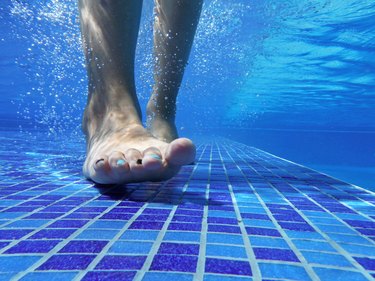
Walking in water can be an effective, low-impact exercise for people of different ages and fitness levels. Calories burned water jogging or walking vary, depending on your speed and level of exertion.
Tip
Water walking and water aerobics burn approximately 240 to 356 calories per hour. Your actual calorie burn may vary based on your body weight and how fast you are walking.
Video of the Day
Water Walking: Calories Burned
When walking on land, your calorie burn varies depending on the speed you are walking and your body weight. The more you weigh, the more you burn during a session. Walking at a speed of 3.5 miles per hour, you burn between 240 and 356 calories per hour, advises Harvard Health Publishing. This is the same calorie burn as an hour of water aerobics.
Video of the Day
If you increase your speed to 4 miles per hour, you burn between 270 and 400 calories per hour. Although it may be difficult to walk as quickly in water as you do on land, the Arthritis Foundation notes that you will burn more calories in the water due to the greater effort required to overcome the resistance in the water.
While it would be handy to have a water walking calculator to determine the number of calories you burn in a workout, you can estimate your calorie burn using Swimming.org's Calorie Cruncher or the calorie calculator from ExRx.net.
Water Walking Exercise
Start by standing in the pool with the water at waist or chest level. Then simply walk as you would on land. Keep your core engaged and make sure your entire foot makes contact with the bottom of the pool so you aren't just walking on tip toes, advises the Arthritis Foundation.
You can also try walking sideways or backwards to work different muscles and change up your workout. Increase the intensity by walking faster or even moving into a jog.
Tip
As you progress, you may want to move into deeper water. Wear a flotation belt to keep balanced and upright when you water-walk in depths over your head.
You can also mix up your workout with other water training. Consider adding lap swimming or trying a new sport such as water volleyball or water polo. Check your local pool or gym and consider some of these water fitness classes:
- Water aerobics
- Water yoga
- Water toning
- Deepwater running
Aquatic Exercise Benefits
You work harder against the resistance of water to move forward than you do on land. According to Bucknell University, water adds an additional 12 to 14 percent resistance compared to walking on land. In addition to allowing your muscles to work hard against the water, this also prevents you from performing fast or jerky movements that may result in injury.
If you have an injury or sore joints from a condition like arthritis, water walking is an excellent choice for aerobic activity as the water makes you more buoyant and reduces the pressure on your joints. Water also dissipates your body heat more effectively, lessening the chance that you will become overheated. If you are walking in a warmer pool, the warmth will help to soothe your joints.
Water walking is more than just a good cardio workout that improves your endurance and circulation and helps you lose and maintain your weight. The resistance of the water also helps develop muscular strength and flexibility.
It is a safe and fun form of exercise that gives you the chance to meet and exercise with others at the pool. There are many psychological benefits as well including reduced stress and increased energy and a greater sense of well-being.